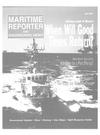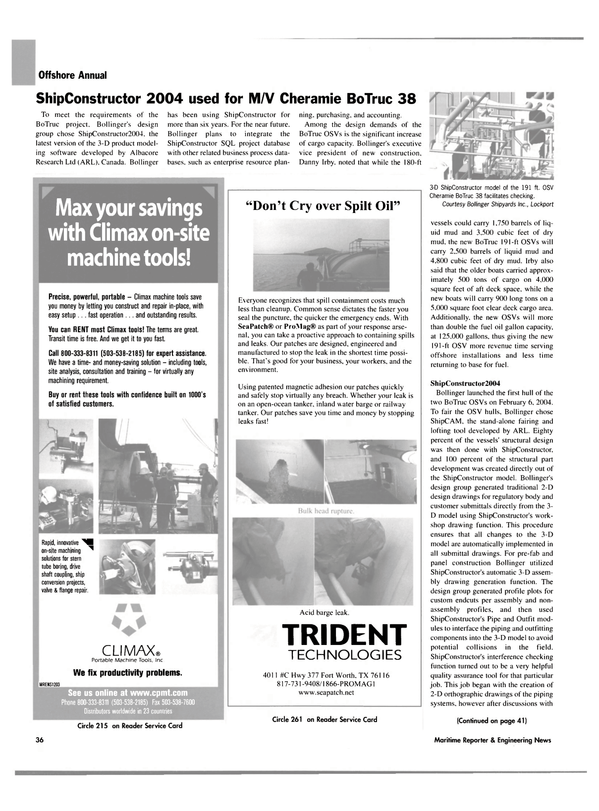
Stability Software for Semi Submersible Rigs
Not all stability software is made equal. Even if all commonly available stability programs were of the same quality, virtually all of them are designed first and foremost for conventional vessels - and it's no secret that the unique characteristics of offshore platforms demand capabilities not usually required for ships. Rig stability is a very critical issue, and it can also be quite complex. What rig operators need is software that can constantly monitor and predict stability in any combination of circumstances; but what they don't need is an interface as complex as the problem.
Enter Autoload Rig. Only recently released, yet already installed on more then 15 platforms. Autoload has also been chosen for the biggest floating rig ever built: Thunderhorse.
Autoload Rig was designed specifically for the Offshore industry, with a completely new interface resulting from rig operator recommendations. From the start, Autoship Systems Corporation (ASC) adopted a simple philosophy: with one brief look at the screen, you must be able to get a clear picture of the vessel's current stability status, loads, and important margins. Quick and accurate understanding means that you are better able to make critical decisions, while leaving the mathematical complexity of the problem to the computer. In addition. Autoload Rig is designed to be tailored to virtually any customer or vessel-specific requirement.
ASC spoke with rig operators and designers, and what the industry told them was that critical information needs to be readily identifiable, must not be hidden, and must always be found in the same place. It's interesting that this is not the trend in most software for desktop computers - the normal Windows environment presents you with layers of windows, each capable of being closed or minimized. There are reasons why this paradigm is popular, not the least being that it allows you to put up any combination of data... but it also places the onus on the user to organize and keep track of all that data. That's great if you are writing a memo and attaching a spreadsheet, but doesn't help you get a clear picture when time is short and the conditions are and marine loads (mooring and risers). You can enter loads (and even set compartment damage) directly within the rig images.
Loads Frame Tables for showing and editing all loads, divided into tank loads and "fixed" (non-liquid) loads.
(See Fig. 1) ASC decided to develop this new interface for use on conventional vessels as well (as Autoload Version 6.0).
As a result, the "new" interface developed from Autoload Rig is now being used on a tanker vessel operated by Teekay Shipping Ltd., and is being installed on several new-build bulk carriers for Westwood Shipping Lines. Even though the interface clearly reflects the needs of the Offshore industry, it is still important to look behind it —after all, in the software industry what you see on the screen may not always be representative of what you are actually getting.
Fortunately, though, Autoload's hydrostatic engine - the software at its heart - is based on experience gained from 20 years of providing hydrostatic prediction software (Autohydro) for vessel designers, and stability software for the marine shipping industry.
Autohydro is used by over 1000 engineering companies around the world, and is tested and approved by most governing approval bodies. In the offshore market.
major design offices like GVA Consulting and the Aker & Kvaerner Group have been using Autohydro for rig stability for more then 15 years. Just as Autohydro is the industry standard for offshore design offices.
Autoload Rig is proving very popular with the rigs designed by these offices - because they both rely on the same 3-D mathematical model. In other words, the same rig model is used in both the design process and actual operations. The importance of this model should not be underestimated.
The vessel model is a key element in the accuracy and flexibility offered by Autoload. The model is truly 3-D and is inclusive of all volumes (tanks, holds, empty spaces, etc). The mathematical treatment of this model gives a true simulation of any floating condition, including real shift of CG for slack tanks, true wind heeling moment, and accurate damage simulation (loss of buoyancy method). If a table-based system is designed to give comparable outputs, it would simply be incapable of achieving the level of accuracy represented by Autoload Rig. (See Fig. 2) The flexibility and accuracy provided by both the 3- D model and a proven, state-of- the-art hydrostatic engine is also key to fulfilling the specific requirements of the offshore industry. Challenges specific to offshore platforms include: • unlike conventional vessels, a rig's stability is critical in any direction.
• different stability restrictions according to drilling, survival, or temporary conditions.
• due to the complex geometry of a rig, the waterplane area (the various parts of the structure breaking the waterplane) - and therefore also the rigs stability - varies significantly with changes in draft (ballasting) or inclination.
• small water plane area relative to the rig's displacement.
which (for example) means that damage to one pontoon peak tank could easily result in an inclination of more than 10 degrees.
With Autoload's 3-D model you can easily predict the effect that damage will have on stability in any direction; the software calculates real shift of free surface in slack tanks according to any change in heel or trim. Real-time sensor data is used for tank contents, drafts, mooring tension, riser tension and wind, while the software accommodates different sets of criteria for different modes of operation. A separate view frame monitors the actual maxVCG curve relative to the current condition (draft/vcg).
(See Fig. 3) Finally, ASC hasn't forgotten to account for the time-honoured programmers dictum, "nonsense in, nonsense out (replace the word "nonsense" as you please). What if data that should have been manually entered somehow gets omitted? What happens if a sensor is mis-reading, or if an operator enters incorrect data? This is where the 3-D model of the displacing vessel saves the day: Autoload Rig compares the "calculated draft" with the "real draft", and solves to find the "constant" weight that accounts for the difference. If this "constant weight" and its calculated centre of gravity are within a specified limit, then the loading condition is considered correct. If the constant weight falls outside the limits, the operator is warned and must find the reason for the discrepancy. If you need stability software for an offshore vessel of any kind, then it is worth contacting an ASC dealer for more information.
During the 24 years Autoship Systems Corporation has been producing worldclass CAD/CAM and load management software, it has amassed thousands of customers — including the US Navy, US Coast Guard, Newport News Shipbuilding, Teekay Shipping Ltd, Halliburton Subsea, CS Marine Technology Corporation, Rolls Royce, Westwood Shipping Lines, and Wallenius Wilhelmsen Lines, plus private companies and government agencies in every corner of the world. ASC also recently partnered with CS Marine Technology Corporation to offer consulting services for owners and vessel designers doing business in China. ASC's latest load management and stability products include Lloyds and DNV-approved Stowage Management Systems for ro-ro, container, bulk, tanker, and break bulk vessels (all with Autoload included in the system).
Their latest CAD/CAM offerings include Autoship 8.3 (for release next month) for hull design and surface modelling, Autostructure 3.0 for internal structural design. Production Manager 3.0 for nesting and other production support, and of course Autohydro 6.0.
Circle 4 9 on Reader Service Card
Read Stability Software for Semi Submersible Rigs in Pdf, Flash or Html5 edition of April 2004 Maritime Reporter
Other stories from April 2004 issue
Content
- Rocknes Successfully Parbuckled page: 8
- Galtex Pilots Order New Jet Boat page: 9
- Meyer Werft Delivers New RoRo-Cruise Ferry page: 10
- Bollinger Launches Innovative OSV Hull page: 12
- Port Pile Up? page: 14
- U.S. Manifest Presentation Requirements page: 17
- Terrorist and Bogus Marine Credentials page: 23
- Rig Demand in the Doldrums page: 24
- The Future is Now page: 30
- SNAME: Investing in the Future page: 32
- Offshore Prospects Keep Bollinger Busy page: 34
- Bollinger Delivers ATB for Bouchard page: 34
- ShipConstructor 2 0 0 4 used for M/V Cheramie BoTruc 38 page: 36
- Stability Software for Semi Submersible Rigs page: 38
- VT Halter: King has Company Back on Track page: 40
- Teekay Enters LNG With Tapias Acquisition page: 42
- Drewry Forecasts Strong LNG Growth page: 42
- ChevronTexaco to Operate New LNG Carrier page: 43
- ABS Addresses Tech Concerns page: 44
- Dual-fuel Diesel Engines for LNG Carriers page: 46
- Graig Extends Cooperation With Vinashin page: 49
- Teekay Seeks to Grow Suezmax Fleet page: 50
- SMT: Safe and Cost Effective Mooring page: 50
- Wilh. Wilhelmsen ASA: Profits to Roll Through 2004 page: 52
- Farstad: North Sea Utilization Rates Down page: 54
- ConCat Survey Cat Trolls for Buyers page: 55
- Berge Boston Gets New Ship Security System page: 56
- Kongsberg Maritime: United, Diverse page: 57
- The Rules are About to Change page: 60
- Cool Technology page: 62
- Advanced Joint Health Service Support and Sea Basing Concept page: 64


